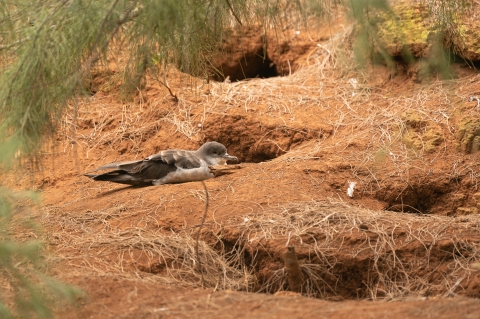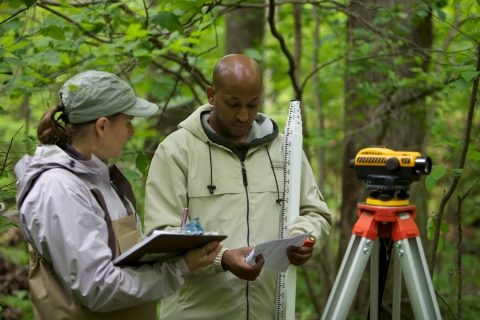Evaluating Impacts of Actions to Migratory Birds
The Service provides recommendations on how to consider and incorporate migratory bird conservation into project planning, design, and implementation to reduce the direct and incidental take of birds. We encourage Federal agencies to incorporate these recommendations into management plans and/or National Environmental Policy Act (NEPA) documents evaluating the effects of the agency’s action(s) on migratory birds. Analysis pursuant to NEPA is required for all discretionary federal actions including issuing regulations, developing plans, providing permits for federal or private actions, funding private actions, making federal land management decisions, and constructing publicly-owned facilities, among many other types of actions.
To evaluate the impacts of an activity on migratory birds, the Service recommends the following actions:
Jump to a section:
Identify | Assess Risk | Avoid and Minimize | Mitigate | Evaluate Effectiveness | Adaptive Management
A. Identify
Identify the migratory bird species or species groups that may be affected by the activity and take the following steps:
1. Assess the regional setting and which species or groups use the project and surrounding area. For migratory species, consider the time of year the project will occur and what species may be present during that time. Data should be presented in both a project footprint and regional context for the purpose of later comparing the environmental consequences of the proposed action and its alternatives.
2. Determine the conservation status of the migratory bird species or groups identified in the project area, including Birds of Conservation Concern (BCC). Take of individuals of species on the List of Endangered and Threatened Wildlife (50 CFR 17.11) requires a permit from the Service. BCCs and other species with declining or isolated populations may be disproportionately affect by the project, compared to more stable and widespread populations.
3. Assess the resources within the project area and how those resources are used for nesting, feeding, or sheltering by the migratory bird species or groups present in the project area.
4. Characterize the abundance and diversity of birds within the project area to fully understand the functions provided by the affected environment to birds.
5. Document the methods and sources used to identify how migratory birds may be affected, including any limitations and uncertainties regarding the information used. Transparency is important to emphasize during the NEPA process. If you have incomplete or unavailable information on birds, check with the Service for assistance. If you are still uncertain, it is better to be upfront about the limitations and uncertainties within your NEPA document.
B. Assess Risk
Assess the risks to the migratory bird species and groups identified. Include direct impacts, those caused immediately by an alternative, and indirect impacts, which are caused by an alternative but removed in space or time.
1. Evaluate how the project may result in the incidental take of migratory birds. “Incidental take” is take that results from an activity but is not the purpose of the activity.
a. Consider the effects of nesting substrate removal or modification, including both one-time and ongoing actions. Vegetation removal and human presence may result in habitat fragmentation and displacement of migratory birds. Birds, or their eggs or young, may also be directly taken if vegetation removal occurs during the breeding season.
b. Consider the effects of infrastructure, including temporary and permanent infrastructure. The presence of structures can result in area avoidance by birds and act as a barrier to bird movements. Structures can also pose a collision risk to birds. These can result in reduced productivity by migratory birds and illness or death of migratory birds.
c.Consider the effects of hazardous attractants, such as lighting. At night or during low visibility conditions, artificial lighting attracts or disorients migrating birds. This can lead to collisions with structures or other birds. Artificial lighting can also pose nonlethal fitness costs on birds through migration, by reducing their physiological condition, change their migration timing and routes, and alter their ability to navigate.
2. Evaluate other actions conducted within or adjacent to the project that may also affect migratory birds.
C. Avoid and Minimize
Avoid and minimize the identified effects to migratory birds to the extent practicable.
- Plan, design, and site projects in locations that avoid the take of migratory birds, in particular the take of Birds of Conservation Concern, to the extent practicable.
Identify and incorporate measures to avoid and minimize the take of migratory birds, in particular the take of Birds of Conservation Concern. Develop performance metrics for each of the conservation measures. These metrics should be adaptive and able to change if they are not capturing the performance mitigation measures.
D. Implement Compensatory Mitigation
When appropriate, identify and implement compensatory mitigation to mitigate the impacts of the activity on migratory birds.
- Compensatory mitigation should be considered whenever an action causes permanent impacts that cannot be avoided or minimized.
- Compensatory mitigation is provided for under the Bald and Golden Eagle Protection Act and allowed under NEPA as a means to mitigate impacts below a significance threshold.
E. Consider Population-Level Effects and Evaluate Effectiveness of Implemented Measures
For take caused by activities that may have a population-level effect on migratory birds, develop and implement methods to determine the effects of the activity on migratory birds.
- Evaluate the impacts to migratory birds caused by the project. Evaluate residual impacts (adverse or beneficial) to migratory bird resources after conservation measures are applied. The residual impacts should then be evaluated for significance, using the criteria developed for each resource.
- Evaluate the effectiveness of implemented avoidance and minimization measures.
F. Adaptive Management
For activities where take may have significant effects on migratory birds, develop and implement an adaptive management approach.
An adaptive management plan is based on the best available science, monitors advances in scientific understanding regarding the effects of a project, adjusts to project operations and practices, and identifies criteria for implementation of the mitigation hierarchy, including avoidance, minimization, and compensation actions.
If you would like to provide comments on the information presented on this webpage, please contact the USFWS Migratory Bird Program at MigratoryBirds@fws.gov.





